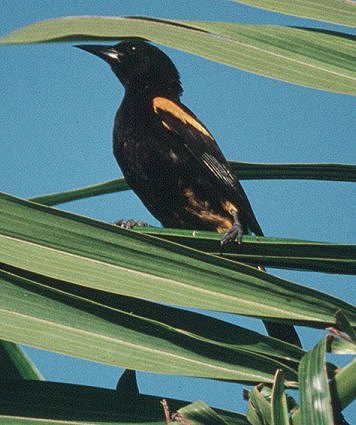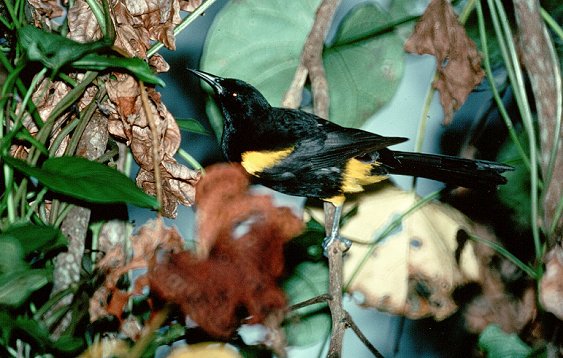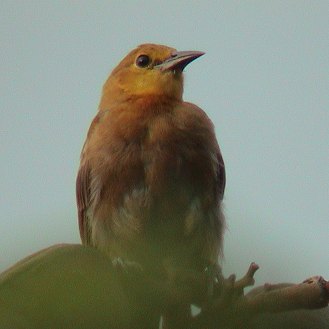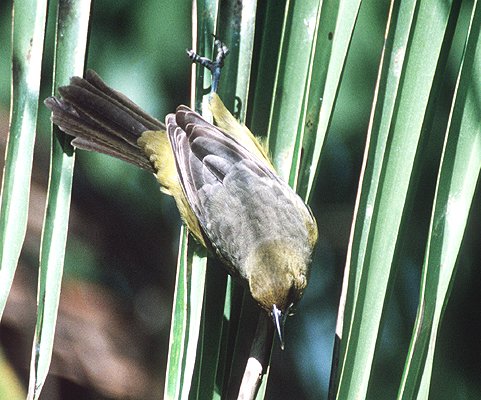|
Greater Antillean Oriole Icterus dominicensis Calandria,
|
 |
|
Photo: M. Oberle
|
|
Greater Antillean Oriole Icterus dominicensis Calandria,
|
 |
|
Photo: M. Oberle
|
|
IDENTIFICATION: The adult Greater Antillean Oriole is black, with a yellow wing patch, and yellow patches on the rump and on the underside at the base of the tail. Immature birds are olive green. Length: 20-22 cm.; weight: 37 g. VOICE: The song is high-pitched whistle, given especially at dawn, but during the day it utters a harsh, "chick" note, as it hops around in trees foraging for food. Audio 6 (M. Oberle). HABITAT: Dry and moist forests, including shade-grown coffee plantations, citrus orchards, mangroves, palm groves, urban gardens. HABITS: Eats mostly insects in the forest canopy and mid-story, but will also consume forest fruits and juices of overripe oranges. Insect prey include earwigs, crickets, grasshoppers, roaches, cicadas, weevils, caterpillars, ants and wasps. It also eats spiders, scorpions, lizards and frogs. Like many members of the blackbird family, it has unusually strong muscles at the base of the skull that allow it to open its bill against resistance. Thus the oriole can look for prey by prying open bromeliads, curled leaves, bark, or soft wood---a feeding technique known as gaping. It forages by methodically hopping from one branch to the next, sometimes hanging upside down, to inspect likely locations for insects. Its fibrous, hanging nest is typical of orioles, and is often placed in a palm tree. The female takes on most of the tasks of nest building, incubating its 3-4 brownish or bluish eggs, and feeding the nestlings. The young birds often flock with the parents during much of the following year. STATUS AND CONSERVATION: A common species in forested areas, but threatened by cowbird nest parasitism. RANGE: Found on Cuba, Hispaniola, Puerto Rico, and some of the Western Bahamas. A typical site to find this bird is at Maricao state forest or the grounds of the parador, Hacienda Juanita. TAXONOMY: PASSERIFORMES; ICTERIDAE. Formerly called the Black-cowled Oriole, but recently split from the Central American form as two different species: the Greater Antillean Oriole (Icterus dominicensis) in the West Indies, and the Black-cowled Oriole (Icterus prosthemelas) in Central America. Some studies in progress now suggest that the races on different Caribbean islands may represent four different species. The Puerto Rican race (Icterus dominicensis portoricensis) is blacker than races elsewhere in the Antilles. The islands of Montserrat, St. Lucia, and Martinique have their own endemic oriole species (Icterus oberi, Icterus laudabilis, and Icterus bonana, respectively) that are thought to have evolved from the Greater Antillean Oriole. The Montserrat Oriole is threatened due to deforestation, and, more recently, the volcanic eruptions that have destroyed much of its limited remaining habitat. For updates on that oriole, see: http://sei.org/o_pva.html. |
 |
|
Photo: M. Oberle
|
 |
|
Photo: J. Faaborg*
|
 |
|
Photo: A. Iñigo
|
 |
|
Photo: A. Iñigo
|
 |
|
Photo: G. Beaton
|
 |
|
Photo: M. Oberle
|
 |
|
Immature - Photo: R. Rodríguez Mojica
|
 |
|
Immature, Bahamas race (Icterus dominicensis northropi)
-
Photo: B. Hallett |
|
References Arendt, W. J., Gibbons, D. W. and Gray, G. 1999. Status of the volcanically threatened Montserrat Oriole Icterus oberi and other forest birds in Montserrat, West Indies. Bird Conserv. Internatn. 9: 351-372. Jaramillo A. and P. Burke. 1999. New World Blackbirds: The Icterids. Princeton Univ Press. Omland, K. E. S., S. M. Lanyon, and S. J. Fritz. 1999. A molecular phylogeny of the New World Orioles (Icterus): The importance of dense taxon sampling. Molecular Phylogeny and Evolution 12:224-239. Orians, G. 1985. Blackbirds of the Americas. Univ. of Washington Press, Seattle, WA. Post, W. 1981. Biology of the Yellow-shouldered Blackbird (Agelaius xanthomus) on a tropical island. Bull. of the Florida State Museum Biol. Sci. 26:125-202. Raffaele, H.A. 1989. A guide to the birds of Puerto Rico and the Virgin Islands. Princeton. Raffaele, H.A. 1989. Una guía a las aves de Puerto Rico y las Islas Vírgenes. Publishing Resources, Inc., Santurce, PR. Raffaele, H.A., J.W. Wiley, O.H. Garrido, A.R. Keith, and J.I. Raffaele. 1998. Guide to the birds of the West Indies. Princeton. Recher, H.F. and J. T. Recher. 1966. A contribution to the knowledge of the avifauna of the Sierra de Luquillo, Puerto Rico. Carib. J. Sci. 6:151-161. Wiley, J.W. 1985. Shiny Cowbird parasitism in two avian communities in Puerto Rico. Condor 87:165-176. Woods, P. 1999. Delayed plumage maturation in orioles. Birding 31(5):416-420. Greater Antilean Oriole, Spanish text Next related species in taxonomic order Previous related species in taxonomic order |